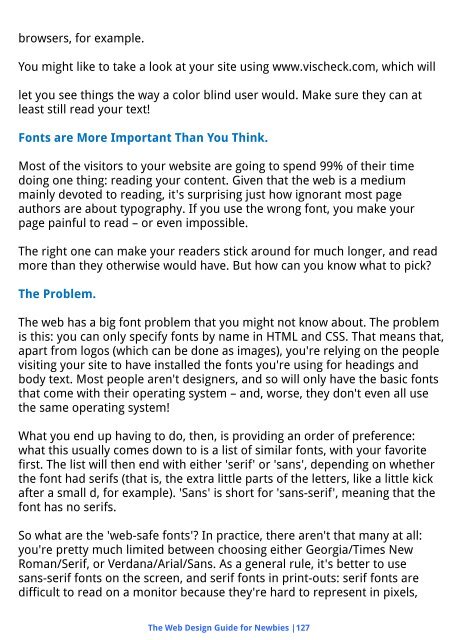You also want an ePaper? Increase the reach of your titles
YUMPU automatically turns print PDFs into web optimized ePapers that Google loves.
owsers, for example.<br />
You might like to take a look at your site using www.vischeck.com, which will<br />
let you see things the way a color blind user would. Make sure they can at<br />
least still read your text!<br />
Fonts are More Important Than You Think.<br />
Most of the visitors to your website are going to spend 99% of their time<br />
doing one thing: reading your content. Given that the web is a medium<br />
mainly devoted to reading, it's surprising just how ignorant most page<br />
authors are about typography. If you use the wrong font, you make your<br />
page painful to read – or even impossible.<br />
The right one can make your readers stick around for much longer, and read<br />
more than they otherwise would have. But how can you know what to pick?<br />
The Problem.<br />
The web has a big font problem that you might not know about. The problem<br />
is this: you can only specify fonts by name in HTML and CSS. That means that,<br />
apart from logos (which can be done as images), you're relying on the people<br />
visiting your site to have installed the fonts you're using for headings and<br />
body text. Most people aren't designers, and so will only have the basic fonts<br />
that come with their operating system – and, worse, they don't even all use<br />
the same operating system!<br />
What you end up having to do, then, is providing an order of preference:<br />
what this usually comes down to is a list of similar fonts, with your favorite<br />
first. The list will then end with either 'serif' or 'sans', depending on whether<br />
the font had serifs (that is, the extra little parts of the letters, like a little kick<br />
after a small d, for example). 'Sans' is short for 'sans-serif', meaning that the<br />
font has no serifs.<br />
So what are the 'web-safe fonts'? In practice, there aren't that many at all:<br />
you're pretty much limited between choosing either Georgia/Times New<br />
Roman/Serif, or Verdana/Arial/Sans. As a general rule, it's better to use<br />
sans-serif fonts on the screen, and serif fonts in print-outs: serif fonts are<br />
difficult to read on a monitor because they're hard to represent in pixels,<br />
The Web Design Guide for Newbies |127


